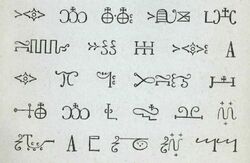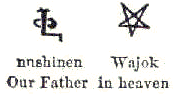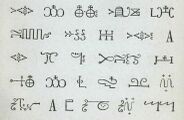Social:Mi'kmaq hieroglyphic writing
| Mi'kmaq hieroglyphs komqwejwi'kasikl | |
|---|---|
 | |
| Type | logographic
|
| Languages | Mi'kmaq |
Time period | 17th–19th century (logographic); date of precursors unknown |
Mi'kmaq hieroglyphic writing was a writing system and memory aid used by the Mi'kmaq, a First Nations people of the east coast of Canada.
The missionary-era glyphs were logograms, with phonetic elements used alongside (Schmidt & Marshall 1995), which included logographic, alphabetic, and ideographic information.[citation needed] They were derived from a pictograph and petroglyph tradition.[1] In Mi'kmaq the glyphs are called komqwejwi'kasikl, or "sucker-fish writings", which refers to the tracks the sucker fish leaves on the muddy river bottom.
Classification
Scholars have debated whether the earliest known Mi'kmaq "hieroglyphs" from the 17th century qualified fully as a writing system, rather than as a pictographic mnemonic device. In the 17th century, French missionary Chrétien Le Clercq adapted the Míkmaq characters as a logographic system for pedagogical purposes.
In 1978, Ives Goddard and William Fitzhugh of the Department of Anthropology at the Smithsonian Institution, contended that the pre-missionary system was purely mnemonic, as it could not be used to write new compositions. Schmidt and Marshall argued in 1995 that the missionary system of the 17th century was able to serve as a fully functional writing system. This would mean that Mi'kmaq is the oldest writing system for a native language north of Mexico.
History
Father Le Clercq, a Roman Catholic missionary on the Gaspé Peninsula in New France from 1675, claimed that he had seen some Míkmaq children 'writing' symbols on birchbark as a memory aid. This was sometimes done by pressing porcupine quills directly into the bark in the shape of symbols. Le Clercq adapted those symbols to writing prayers, developing new symbols as necessary.[citation needed]
This adapted writing system proved popular among Mi'kmaq, and was still in use in the 19th century.[citation needed] Since there is no historical or archaeological evidence of these symbols from before the arrival of this missionary, it is unclear how ancient the use of the mnemonic glyphs was. The relationship of these symbols with Mi'kmaq petroglyphs is also unclear.
Pierre Maillard, Roman Catholic priest, during the winter of 1737–38[2] perfected a system of hieroglyphics to transcribe Mi'kmaq words. He used these symbols to write formulas for the principal prayers and the responses of the faithful, in the catechism, so his followers might learn them more readily. There is no direct evidence that Maillard was aware of Le Clercq's work; in any event Maillard's work is outstanding in that he left numerous works in the language, which continued in use among the Mi'kmaq into the 20th century.
An unknown number of birch scrolls containing mi'kmaq writings were destroyed by missionaries in New England, before the writing system was adapted to aid conversion of community members to Christianity.[citation needed]
Examples
-
The beginning of the Lord's Prayer in Míkmaq hieroglyphs. The text reads Nujjinen wásóq – "Our father / in heaven"
-
The full text.
-
The Ave Maria.
-
Text of the Rite of Confirmation in Míkmaq hieroglyphs. The text reads Koqoey nakla msɨt telikaqumilálaji? – literally 'Why / those / all / after he did that to them?', or "Why are all these different steps necessary?"
-
Page 5 of Buch das gut, enthaltend den Katechismus by Christian Kauder
See also
- Wiigwaasabak – Ojibwe hieroglyphic birchbarks
References
- ↑ Edwards, Brandan Frederick R. Paper Talk: A History of Libraries, Print Culture, and Aboriginal Peoples in Canada before 1960. Toronto: The Scarecrow Press, Inc. 2004 ISBN 978-0-8108-5113-9 p.11 [1]
- ↑ Johnson, Micheline D. (1974). "Maillard, Pierre". in Halpenny, Francess G. Dictionary of Canadian Biography. III (1741–1770) (online ed.). University of Toronto Press. http://www.biographi.ca/en/bio/maillard_pierre_3E.html. Retrieved 4 October 2009.
Bibliography
- Goddard, Ives, and William W. Fitzhugh. 1978. "Barry Fell Reexamined", in The Biblical Archaeologist, Vol. 41, No. 3. (September), pp. 85–88.
- Hewson, John. 1982. Micmac Hieroglyphs in Newfoundland. Languages in Newfoundland and Labrador, ed. by Harold Paddock, 2nd ed., 188-199. St John's, Newfoundland: Memorial University.
- Hewson, John. 1988. Introduction to Micmac Hieroglyphics. Cape Breton Magazine 47:55-61. (text of 1982, plus illustrations of embroidery and some photos)
- Kauder, Christian. 1921. Sapeoig Oigatigen tan teli Gômgoetjoigasigel Alasotmaganel, Ginamatineoel ag Getapefiemgeoel; Manuel de Prières, instructions et changs sacrés en Hieroglyphes micmacs; Manual of Prayers, Instructions, Psalms & Hymns in Micmac Ideograms. New edition of Father Kauder's Book published in 1866. Ristigouche, Québec: The Micmac Messenger.
- Lenhart, John. History relating to Manual of prayers, instructions, psalms and humns in Micmac Ideograms used by Micmac Indians of Eastern Canada and Newfoundland. Sydney, Nova Scotia: The Nova Scotia Native Communications Society.
- Schmidt, David L., and B. A. Balcom. 1995. "The Règlements of 1739: A Note on Micmac Law and Literacy", in Acadiensis. XXIII, 1 (Autumn 1993) pp 110–127. ISSN 0044-5851
- Schmidt, David L., and Murdena Marshall. 1995. Míkmaq Hieroglyphic Prayers: Readings in North America's First Indigenous Script. Nimbus Publishing. ISBN 1-55109-069-4
External links
- Míkmaq Portraits Collection Includes tracings and images of Míkmaq petroglyphs
- Micmac at ChristusRex.org A large collection of scans of prayers in Míkmaq hieroglyphs.
- Écriture sacrée en Nouvelle France: Les hiéroglyphes micmacs et transformation cosmologique (PDF, in French) A discussion of the origins of Míkmaq hieroglyphs and sociocultural change in the 17th century Micmac society.




